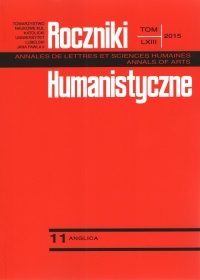The theatrical world of Flannery O’Connor’s “A Late Encounter with the Enemy”
Abstract
Attempting a scrutiny of Flannery O’Connor’s short story entitled “A Late Encounter with the Enemy,” the reader is by no means left in a quandary as to the experience of death, pain, and suffering percolating through the very foundations of southern culture since antebellum times. Also, the phenomenon in question appears to be deeply embedded in the aesthetics of historical baroque, which allows one to notice a striking resemblance between the nature of southern experience of the 1950’s and the essence of baroque sensibility. Such an observation assumes extraordinary importance if considered in the context of modern theatricality.
Grounded upon a comparison between the seventeenth-century France of Louis XIV and the contemporary South of O’Connor’s protagonist, George Poker Sash, the article explores the transplantation of a multitude of cultural traits characterizing the baroque onto the realm of modern experience(impelled to confront southern history by the author) through the prism of such notions as the play of appearances, miseen abime, and the spaces of theatricality. These concepts, predominantly associated with the theater, are delineated in the course of William Egginton’s How the World Became a Stage: Presence, Theatricality, and the Question of Modernity and The Theater of Truth: Ideology of Neo-Baroque Aesthetics, which two works comprise the theoretical background of the discussion concerning the relationship between the contemporary South and its historical experience.
The argument is supported by Guy Debord’s conceptualization of the spectacle adumbrated in The Society of the Spectacle, which presents the culture of the commodity as endowed with theatrical attributes. Bearing in mind that fact that, as Christine Buci-Glucksmann argues in her Baroque Reason, the representation of a historical subject in necessarily connected with theatricality, O’Connor reader is enabled, with the assistance of the works mentioned above, to locate the tragedy ensconced in the core of southern culture enveloped in an intricately woven web of modern appearances.
References
Balee, Susan. Flannery O’Connor: Literary Prophet of the South. New York: Chelsea House Publishers, 1995.
Benjamin, Walter. The Origin of German Tragic Drama. Tr. John Osborne.London: Verso, 1998.
Buci-Glucksmann, Christine. Baroque Reason: The Aesthetics of Modernity. 1984. Tr. Patrick Camiller. London: Sage Publications, 1994.
Calabrese, Omar. Neo-Baroque: A Sign of the Times. Tr. Charles Lambert. Princeton: Princeton UP, 1992.
Debord, Guy. The Society of the Spectacle. Tr. Donald Nicholson-Smith. New York: Zone Books, 1994.
Desmond, John. Risen Sons: Flannery O’Connor’s Vision of History. Athens: TheUniversity of Georgia Press, 1987.
Driskell, Leon, Joan Britain. The Eternal Crossroads: The Art of Flannery O’Connor. Lexington: The University Press of Kentucky, 1971.
Egginton, William. How the World Became a Stage: Presence, Theatricality, and the Question of Modernity. Albany: State University of New York Press, 2003.
Egginton, William. The Theater of Truth: The Ideology of (Neo)Baroque Aesthetics. Stanford: Stanford UP, 2010.
Feeley, Kathleen. Flannery O’Connor: Voice of the Peacock. New Brunswick: Rutgers UP,1972.
Giannone, Richard. Flannery O’Connor and the Mystery of Love.New York: Fordham UP, 1999.
Goffman, Erving. The Presentation of Self in Everyday Life. Edinburgh: University of Edinburgh Social Sciences Research Center, 1956.
Gone with the Wind. By Margaret Mitchell Dir. Victor Fleming. Writ. Sidney Howard. Prod. David Selznick. Perf. Clark Gable, Vivien Leigh, Leslie Howard, Olivia de Havilland, and Hattie McDaniel, Metro-Goldwyn-Mayer. 1939. (USA)
Gooch, Brad. Flannery: A Life of Flannery O’Connor. New York: Hachette Book Group, 2009.
Hendin, Josephine. The World of Flannery O’Connor. Bloomington: Indiana UP, 1970.
Hobson, Fred. “The New South: 1880-1940.” The Literature of the American South: A Norton Anthology. Ed. William Andrews, Minrose Gwin, Trudier Harris, and Fred Hobson, 245–253. New York: Norton, 1998.
Kilcourse, George. Flannery O’Connor’s Religious Imagination: A World with Everything Off Balance. New York: Paulist Press, 2001.
Lambert, Gregg. The Return of the Baroque in Modern Culture.London: Continuum, 2004.
Maravall, José. Culture of the Baroque: Analysis of a Historical Structure. Tr. Terry Cochran. Manchester: Manchester UP, 1986.
Ndalianis, Angela. Neo-Baroque Aesthetics and Contemporary Entertainment. Cambridge: The MIT Press, 2004.
Northup, Solomon. Twelve Years a Slave. New York: Miller, Orton & Mulligan. 1853.
Accessed Oct 10, 2015.
O’Connor, Flannery. “A Late Encounter with the Enemy.” 1955. Flannery O’Connor: Collected Works, 252–262. New York: The Library of America, 1988.
Simpson, Lewis P. The Dispossessed Garden: Pastoral and History in Southern Literature. Baton Rouge: Louisiana State UP, 1975.
Srigley, Susan. Flannery O’Connor’s Sacramental Art. Notre Dame: Notre Dame UP, 2004.
Sykes, John. Flannery O’Connor, Walker Percy,and the Aesthetic of Revelation. Columbia: U of Missouri P, 2007.
Weiss, Allen. Mirrors of Infinity: The French Formal Garden and 17th-Century Metaphysics. New York: Princeton Architectural Press, 1995.
Turner, Bryan. Introduction. Baroque Reason: The Aesthetics of Modernity. By Christine Buci-Glucksmann. 1984. Tr. Patrick Camiller, 1–42. London: Sage Publications, 1994.
Wood, Ralph C. Flannery O’Connor and the Christ-Haunted South.Grant Rapids: William B. Eerdmans Publishing Company, 2005
Copyright (c) 2015 Roczniki Humanistyczne

This work is licensed under a Creative Commons Attribution-NonCommercial-NoDerivatives 4.0 International License.





